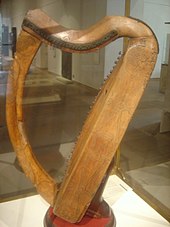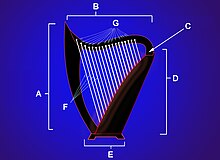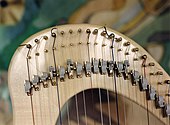Celtic harp

As a Celtic harp , even Gaelic or Irish harp , Scottish Gaelic Clàrsach , Irish Cláirseach , Breton Telenn , Welsh telyn traditional are harps from Ireland , the Brittany , Wales and Scotland indicated that stand out above all by the typical curved shape of the column. The shape of the body varies between the simple box shape and shapes with a rounded back.
The mood is mostly diatonic . There are also Celtic hooked harps , with which a chromatic game is possible, and diatonic and chromatic Celtic double harps .
history
The oldest known European harps come from Ireland and Scotland. They are dated around the 15th century and based on their artistic design it is believed that they were made in Argyll , south west Scotland.
These historical harps are strung with bronze strings over a solid willow wood resonance body. The reinforced column is curved and the neck is carved and flanked by broad brass bands. It is believed that it was played with the fingernails.
One of these medieval harps, often romantic as "harp of Brian Boru is called," is located in the Trinity College Library in Dublin . Two more, the "Queen Mary Harp" and the "Lamont Harp", are in the Scottish National Museum in Edinburgh .
There are at least 15 other early Celtic harps that date from post-medieval times to 1800. Although most are in Ireland and are commonly believed to be of Irish origin, they could also be from Scotland.
Modern celtic harps
Modern Celtic harps are often replicas of historical instruments such as the "Queen Mary Harp" or the "Sirr Harp".
These harps are between 0.7 and 1.6 m high and have up to 34 diatonic tuned nylon , carbon or gut strings . In contrast to the concert harp, this means a smaller range in the bass range. So-called lap harps have 26 strings. The strings are a little less tensioned and run closer together. The soundboard is straight, the string angle to the sound box corresponds to that of the concert harp.
Cherry , maple , walnut , rarely pear wood and oak are used as building materials for the load-bearing parts . The soundboard is usually spruce (cross-grained), rarely covered with veneer .
The playing techniques of most instrumentalists differ only marginally from those of the concert harp ; the instrument is rarely played with fingernails again. In Ireland this harp is called the Neo-Irish harp due to the "innovation" of using gut, carbon or nylon strings instead of bronze or other metal.
The instrument has been played again in Europe and North America since the 1980s after Alan Stivell and Myrdhin in Brittany, Mary MacMaster in Scotland and Rüdiger Oppermann in Germany and France made the instrument popular again. Celtic harps are manufactured individually or industrially in Japan , Italy , France , Pakistan and the USA .
Influence of the Welsh triple harp
In addition to the mostly diatonic Cláirseach, a chromatically tuned variant of the instrument was also developed. Presumably through Italian influence, the Welsh triple harp established itself in Wales , which was also used in Ireland. The string material is worth mentioning here: bronze in the treble and silver or gold in the bass . The metal was compacted by rolling and given additional tensile strength.
symbol

The Celtic harp is the national instrument of Scotland and Ireland. As a symbol of Ireland, it was depicted on the Irish pound coins . Today it can be found on Irish euro coins . It is also found on the coat of arms of the Republic of Ireland and on the Royal Standard . The Irish airline Ryanair also uses the harp in its logo.
Individual evidence
- ↑ The fourth, the Gothic "Wolkenstein Harp" or "Eisenach Harp" from the end of the 14th / beginning of the 15th century, is located on the Wartburg in Eisenach . - http://www.earlygaelicharp.info/harps/foreign.htm
- ↑ Keith Sanger, Alison Kinnaird: Tree of Strings. Crann nan Teud. Kinmor 1992
- ^ DH Caldwell (ed.): Angels Nobles and Unicorns. Art and Patronage in Medieval Scotland. NMS, Edinburgh 1982
- ↑ Keith Sanger; Alison Kinnaird: Tree of Strings. Crann nan Teud. Kinmor 1992
- ↑ http://www.earlygaelicharp.info/harps



